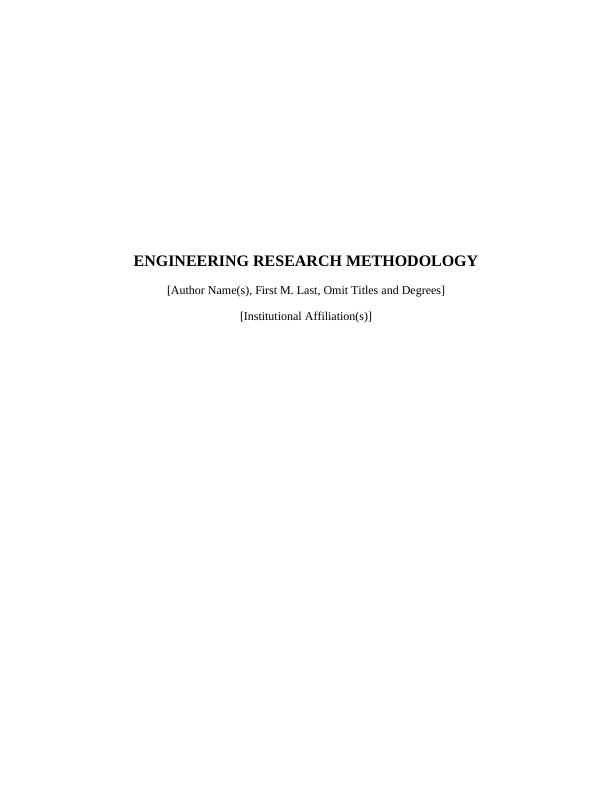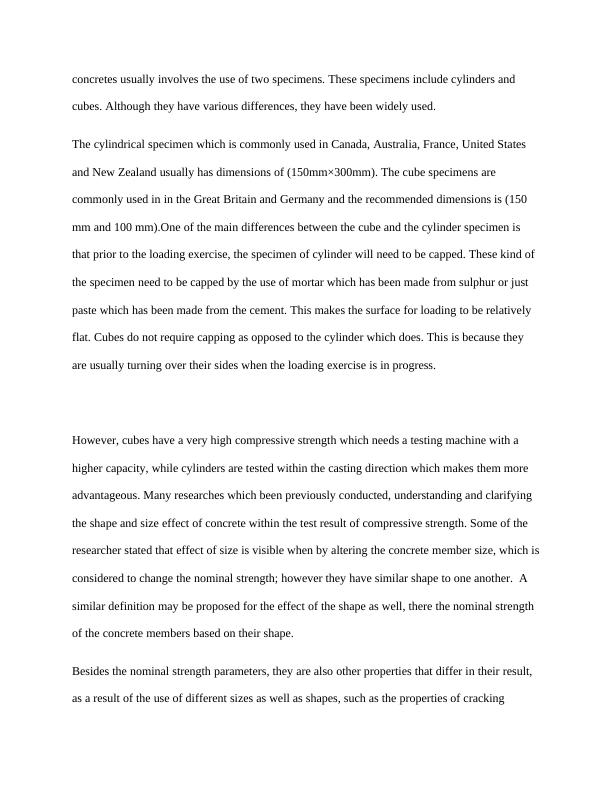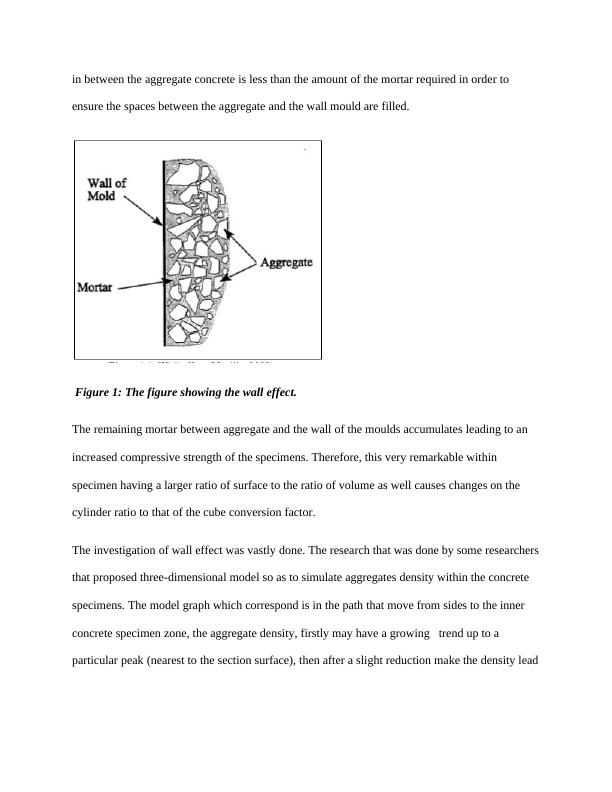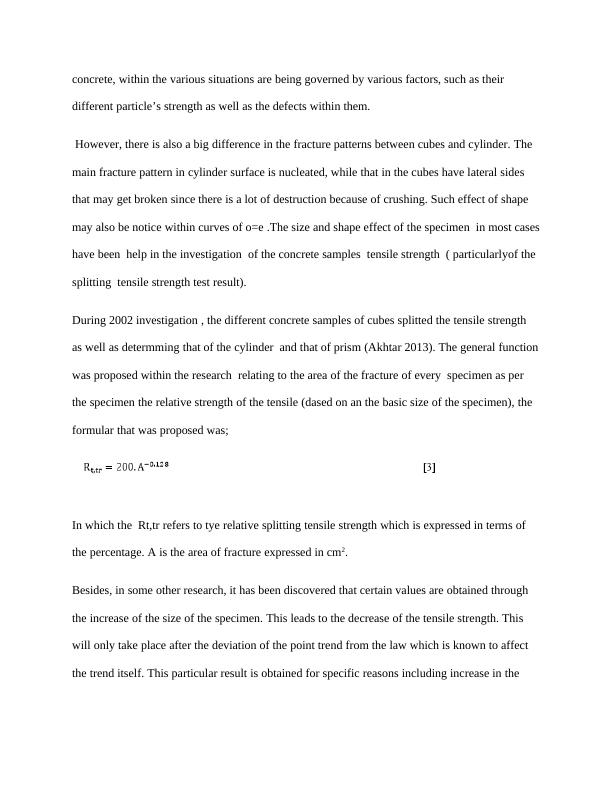Effect of Size and Shape on Compressive Strength of Concrete
The assignment requires the submission of a draft proposal for a research project in the field of engineering. The proposal should include keywords for literature review, a literature review section, research gaps, research questions, project objectives, and research methodology.
40 Pages6160 Words204 Views
Added on 2022-10-12
About This Document
This article discusses the effect of size and shape on compressive strength of concrete. It covers topics such as standard specimens, size and shape of specimens, normal and high strength concrete, workability, and more.
Effect of Size and Shape on Compressive Strength of Concrete
The assignment requires the submission of a draft proposal for a research project in the field of engineering. The proposal should include keywords for literature review, a literature review section, research gaps, research questions, project objectives, and research methodology.
Added on 2022-10-12
ShareRelated Documents
ENGINEERING RESEARCH METHODOLOGY
[Author Name(s), First M. Last, Omit Titles and Degrees]
[Institutional Affiliation(s)]
[Author Name(s), First M. Last, Omit Titles and Degrees]
[Institutional Affiliation(s)]

KEYWORDS
Self-compacting concrete
High strength concrete
Standard Specimens
Size of Specimen
Shape of Specimen
Normal strength concrete
Compression strength
Concrete Workability
Flexural strength
Ground granulated blasted slag furnace
LITERATURE REVIEW
One of the necessary and important experiments which are carried out by civil engineers as far as
the concrete property is concerned is testing of the hardened concrete so that its compressive
strength can be determined. The commonly known experiment for the same process involves
crushing of concretes after the samples have been casted in the laboratory (Agar-Ozbek et al
2013). This is achieved by using relevant machine for testing. The results from the experiment
however can be affected by several factors which are diverse in nature. Some of these factors
include the shape as well as the size of the specimen. Others include the moulds which have been
used for casting, conditions for curing as well as load application rate. The testing of hardened
Self-compacting concrete
High strength concrete
Standard Specimens
Size of Specimen
Shape of Specimen
Normal strength concrete
Compression strength
Concrete Workability
Flexural strength
Ground granulated blasted slag furnace
LITERATURE REVIEW
One of the necessary and important experiments which are carried out by civil engineers as far as
the concrete property is concerned is testing of the hardened concrete so that its compressive
strength can be determined. The commonly known experiment for the same process involves
crushing of concretes after the samples have been casted in the laboratory (Agar-Ozbek et al
2013). This is achieved by using relevant machine for testing. The results from the experiment
however can be affected by several factors which are diverse in nature. Some of these factors
include the shape as well as the size of the specimen. Others include the moulds which have been
used for casting, conditions for curing as well as load application rate. The testing of hardened

concretes usually involves the use of two specimens. These specimens include cylinders and
cubes. Although they have various differences, they have been widely used.
The cylindrical specimen which is commonly used in Canada, Australia, France, United States
and New Zealand usually has dimensions of (150mm×300mm). The cube specimens are
commonly used in in the Great Britain and Germany and the recommended dimensions is (150
mm and 100 mm).One of the main differences between the cube and the cylinder specimen is
that prior to the loading exercise, the specimen of cylinder will need to be capped. These kind of
the specimen need to be capped by the use of mortar which has been made from sulphur or just
paste which has been made from the cement. This makes the surface for loading to be relatively
flat. Cubes do not require capping as opposed to the cylinder which does. This is because they
are usually turning over their sides when the loading exercise is in progress.
However, cubes have a very high compressive strength which needs a testing machine with a
higher capacity, while cylinders are tested within the casting direction which makes them more
advantageous. Many researches which been previously conducted, understanding and clarifying
the shape and size effect of concrete within the test result of compressive strength. Some of the
researcher stated that effect of size is visible when by altering the concrete member size, which is
considered to change the nominal strength; however they have similar shape to one another. A
similar definition may be proposed for the effect of the shape as well, there the nominal strength
of the concrete members based on their shape.
Besides the nominal strength parameters, they are also other properties that differ in their result,
as a result of the use of different sizes as well as shapes, such as the properties of cracking
cubes. Although they have various differences, they have been widely used.
The cylindrical specimen which is commonly used in Canada, Australia, France, United States
and New Zealand usually has dimensions of (150mm×300mm). The cube specimens are
commonly used in in the Great Britain and Germany and the recommended dimensions is (150
mm and 100 mm).One of the main differences between the cube and the cylinder specimen is
that prior to the loading exercise, the specimen of cylinder will need to be capped. These kind of
the specimen need to be capped by the use of mortar which has been made from sulphur or just
paste which has been made from the cement. This makes the surface for loading to be relatively
flat. Cubes do not require capping as opposed to the cylinder which does. This is because they
are usually turning over their sides when the loading exercise is in progress.
However, cubes have a very high compressive strength which needs a testing machine with a
higher capacity, while cylinders are tested within the casting direction which makes them more
advantageous. Many researches which been previously conducted, understanding and clarifying
the shape and size effect of concrete within the test result of compressive strength. Some of the
researcher stated that effect of size is visible when by altering the concrete member size, which is
considered to change the nominal strength; however they have similar shape to one another. A
similar definition may be proposed for the effect of the shape as well, there the nominal strength
of the concrete members based on their shape.
Besides the nominal strength parameters, they are also other properties that differ in their result,
as a result of the use of different sizes as well as shapes, such as the properties of cracking

/fracture pattern together with the stress of the strain curve trends. This includes the associated
risks. The components of the concrete are basically made up of water, cement, air, chemicals,
aggregates and other supplements. The process of the manufacture of the cement is usually
achieved by the use of the controlled combination of the chemicals including shells, limestone,
clay, chalk, silica sand, blast furnace slag and finally iron ore.
The supplementary material which is commonly used is the slag cement, fly ashes and finally
silica fumes. In overcoming the effect of the shape and that of size, then conversion factor must
be proposed concerning various conditions. The initial investigation concerning the size effect
was done in 1925 by the use of a cube of 6’’ and that of 8’’ as well as a cylinder having different
sizes. Testing of various specimens having various ages, while the average ratio of cylinder to
that of cube were 0.85 to 0.88 was obtained.
The effect of different curing condition on the conversion factor that is the cylinder ratio to that
of the cube has also investigated by the same researcher. A part from that, another investigation
was also done concerning the size and shape as their effect to compressive strength of a higher
strength concrete is concerned. As well as proposing to their different conversion factor of 0.8 on
the cylinder 150x 300 /cube 150mm, 0.93 for cylinder 100x200/cube as well as o.86 for a
cylinder 150x300/cylinder 100x200. The finding was, the parameter of mix design also changes
the strength ratio of the cylinder to that of the cube. Whereas the effect of the shape and size has
also been investigated concerning the concrete oh high strength, the result was showing that the
effect of size is more in cubes as compared to that in cylinders.
One factor changing the factor of conversion is the aggregates grading which manifest itself
through the effect of wall. The effect shows that the amount of mortar needed in filling the space
risks. The components of the concrete are basically made up of water, cement, air, chemicals,
aggregates and other supplements. The process of the manufacture of the cement is usually
achieved by the use of the controlled combination of the chemicals including shells, limestone,
clay, chalk, silica sand, blast furnace slag and finally iron ore.
The supplementary material which is commonly used is the slag cement, fly ashes and finally
silica fumes. In overcoming the effect of the shape and that of size, then conversion factor must
be proposed concerning various conditions. The initial investigation concerning the size effect
was done in 1925 by the use of a cube of 6’’ and that of 8’’ as well as a cylinder having different
sizes. Testing of various specimens having various ages, while the average ratio of cylinder to
that of cube were 0.85 to 0.88 was obtained.
The effect of different curing condition on the conversion factor that is the cylinder ratio to that
of the cube has also investigated by the same researcher. A part from that, another investigation
was also done concerning the size and shape as their effect to compressive strength of a higher
strength concrete is concerned. As well as proposing to their different conversion factor of 0.8 on
the cylinder 150x 300 /cube 150mm, 0.93 for cylinder 100x200/cube as well as o.86 for a
cylinder 150x300/cylinder 100x200. The finding was, the parameter of mix design also changes
the strength ratio of the cylinder to that of the cube. Whereas the effect of the shape and size has
also been investigated concerning the concrete oh high strength, the result was showing that the
effect of size is more in cubes as compared to that in cylinders.
One factor changing the factor of conversion is the aggregates grading which manifest itself
through the effect of wall. The effect shows that the amount of mortar needed in filling the space

in between the aggregate concrete is less than the amount of the mortar required in order to
ensure the spaces between the aggregate and the wall mould are filled.
Figure 1: The figure showing the wall effect.
The remaining mortar between aggregate and the wall of the moulds accumulates leading to an
increased compressive strength of the specimens. Therefore, this very remarkable within
specimen having a larger ratio of surface to the ratio of volume as well causes changes on the
cylinder ratio to that of the cube conversion factor.
The investigation of wall effect was vastly done. The research that was done by some researchers
that proposed three-dimensional model so as to simulate aggregates density within the concrete
specimens. The model graph which correspond is in the path that move from sides to the inner
concrete specimen zone, the aggregate density, firstly may have a growing trend up to a
particular peak (nearest to the section surface), then after a slight reduction make the density lead
ensure the spaces between the aggregate and the wall mould are filled.
Figure 1: The figure showing the wall effect.
The remaining mortar between aggregate and the wall of the moulds accumulates leading to an
increased compressive strength of the specimens. Therefore, this very remarkable within
specimen having a larger ratio of surface to the ratio of volume as well causes changes on the
cylinder ratio to that of the cube conversion factor.
The investigation of wall effect was vastly done. The research that was done by some researchers
that proposed three-dimensional model so as to simulate aggregates density within the concrete
specimens. The model graph which correspond is in the path that move from sides to the inner
concrete specimen zone, the aggregate density, firstly may have a growing trend up to a
particular peak (nearest to the section surface), then after a slight reduction make the density lead

the density to a constant amount. The peak point of the graph also increases with the aggregate
fraction.
In case of the specimen for casting, Ground Granulated Blast Furnace Slag which is commonly
known as GGBS was used. The Ground Granulated Blast Furnace Slag belongs to class of 42.5.
The aggregates of the crushed limestone which was obtained from Beşparmak Mountains Cyprus
in case of both coarse and fine were used. The superplasticizer, one concrete mix design and
portable water would also utilized by this particular project. Prior to the casting process, there
would be performance of the sieve analysis hence leading to the determination of the conditions
of moisture of all the aggregates.
Elimination of the influence of the wall has significant effect during the investigation, the sewed
concrete specimens from the casted specimens. Within this research, the findings were that the
size effect pronounced more in concrete sample s of higher compressive strengths that may be
attributed to most of brittle characteristics of the grades. The other finding was that the size
effect always depends on maximum aggregate concrete size, in the medium as well as the high
compressive strengths in the similar manner.
Few studies have been done to give a suggestive equation for converting compressive strength
of various specimens to one another. The example is given in the Hermit’s equation as shown
below
Fu= the compressive strength of the cube in psi.
fraction.
In case of the specimen for casting, Ground Granulated Blast Furnace Slag which is commonly
known as GGBS was used. The Ground Granulated Blast Furnace Slag belongs to class of 42.5.
The aggregates of the crushed limestone which was obtained from Beşparmak Mountains Cyprus
in case of both coarse and fine were used. The superplasticizer, one concrete mix design and
portable water would also utilized by this particular project. Prior to the casting process, there
would be performance of the sieve analysis hence leading to the determination of the conditions
of moisture of all the aggregates.
Elimination of the influence of the wall has significant effect during the investigation, the sewed
concrete specimens from the casted specimens. Within this research, the findings were that the
size effect pronounced more in concrete sample s of higher compressive strengths that may be
attributed to most of brittle characteristics of the grades. The other finding was that the size
effect always depends on maximum aggregate concrete size, in the medium as well as the high
compressive strengths in the similar manner.
Few studies have been done to give a suggestive equation for converting compressive strength
of various specimens to one another. The example is given in the Hermit’s equation as shown
below
Fu= the compressive strength of the cube in psi.

The other famous law and formula, regarding the size effect has been proposed by some of the
researchers. The rule of the size effect explains briefly by the increasing size of the specimens,
the specimen compressive strength of the similar mix design decreases. The formula of the law
is given below
Where ft stands for the concrete tensile strength, B and d0 are both constant, while d is the
dimension characteristics. The same theory has been also by another researcher in 1951. The
weakest linked theory, indicate the larger specimen s are always more willing to contain defects
as well as anomalies themselves, that may cause the fail at lower stresses. A brief explanation of
the conducted experiments is presented in the chapter above. This chapter will therefore present
the results obtained from such experiments in different forms such as graphs; analysis of the
results are also highlighted and then intensive discussions concerning the findings from the
experiments.
Sample of the conducted experiments included a test on fresh concrete involving Vebe test and
slump test. Other experiments included tests on ultrasonic pulse velocity, rebound hammer (non-
destructive tests on hardened concrete), hardened density as well as hardened concrete
destructive tests comprising of test on splitting tensile strength and test on compressive strength.
On other hand, considering the theory of summation by one of the researchers, the specimen
strength without the least particle of the strength is equivalent to the strength summation of every
part of its own parts. In addition, it can be said that the result of various sized specimen of
researchers. The rule of the size effect explains briefly by the increasing size of the specimens,
the specimen compressive strength of the similar mix design decreases. The formula of the law
is given below
Where ft stands for the concrete tensile strength, B and d0 are both constant, while d is the
dimension characteristics. The same theory has been also by another researcher in 1951. The
weakest linked theory, indicate the larger specimen s are always more willing to contain defects
as well as anomalies themselves, that may cause the fail at lower stresses. A brief explanation of
the conducted experiments is presented in the chapter above. This chapter will therefore present
the results obtained from such experiments in different forms such as graphs; analysis of the
results are also highlighted and then intensive discussions concerning the findings from the
experiments.
Sample of the conducted experiments included a test on fresh concrete involving Vebe test and
slump test. Other experiments included tests on ultrasonic pulse velocity, rebound hammer (non-
destructive tests on hardened concrete), hardened density as well as hardened concrete
destructive tests comprising of test on splitting tensile strength and test on compressive strength.
On other hand, considering the theory of summation by one of the researchers, the specimen
strength without the least particle of the strength is equivalent to the strength summation of every
part of its own parts. In addition, it can be said that the result of various sized specimen of

concrete, within the various situations are being governed by various factors, such as their
different particle’s strength as well as the defects within them.
However, there is also a big difference in the fracture patterns between cubes and cylinder. The
main fracture pattern in cylinder surface is nucleated, while that in the cubes have lateral sides
that may get broken since there is a lot of destruction because of crushing. Such effect of shape
may also be notice within curves of o=e .The size and shape effect of the specimen in most cases
have been help in the investigation of the concrete samples tensile strength ( particularlyof the
splitting tensile strength test result).
During 2002 investigation , the different concrete samples of cubes splitted the tensile strength
as well as determming that of the cylinder and that of prism (Akhtar 2013). The general function
was proposed within the research relating to the area of the fracture of every specimen as per
the specimen the relative strength of the tensile (dased on an the basic size of the specimen), the
formular that was proposed was;
In which the Rt,tr refers to tye relative splitting tensile strength which is expressed in terms of
the percentage. A is the area of fracture expressed in cm2.
Besides, in some other research, it has been discovered that certain values are obtained through
the increase of the size of the specimen. This leads to the decrease of the tensile strength. This
will only take place after the deviation of the point trend from the law which is known to affect
the trend itself. This particular result is obtained for specific reasons including increase in the
different particle’s strength as well as the defects within them.
However, there is also a big difference in the fracture patterns between cubes and cylinder. The
main fracture pattern in cylinder surface is nucleated, while that in the cubes have lateral sides
that may get broken since there is a lot of destruction because of crushing. Such effect of shape
may also be notice within curves of o=e .The size and shape effect of the specimen in most cases
have been help in the investigation of the concrete samples tensile strength ( particularlyof the
splitting tensile strength test result).
During 2002 investigation , the different concrete samples of cubes splitted the tensile strength
as well as determming that of the cylinder and that of prism (Akhtar 2013). The general function
was proposed within the research relating to the area of the fracture of every specimen as per
the specimen the relative strength of the tensile (dased on an the basic size of the specimen), the
formular that was proposed was;
In which the Rt,tr refers to tye relative splitting tensile strength which is expressed in terms of
the percentage. A is the area of fracture expressed in cm2.
Besides, in some other research, it has been discovered that certain values are obtained through
the increase of the size of the specimen. This leads to the decrease of the tensile strength. This
will only take place after the deviation of the point trend from the law which is known to affect
the trend itself. This particular result is obtained for specific reasons including increase in the

End of preview
Want to access all the pages? Upload your documents or become a member.
Related Documents
Concrete Mix & Cast Report - Design, Constituents, Resultslg...
|7
|1051
|442
Concrete Strength: Effects of Water/Cement Ratio on Workability and Compressive Stresslg...
|9
|1795
|319
Civil Engineering | Assignmentlg...
|19
|2655
|15
Soil and Materials Lab Report on Concrete Mixing Ratio and Strength Testinglg...
|16
|2506
|328
Fracture Toughness Test Analysis Reportlg...
|7
|1070
|461
Size And Shape Effects On The Compressive Strength Of High Strength Concretelg...
|16
|3296
|247
